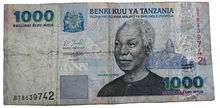Tanzanian shilling
The shilingi (Swahili; English: shilling; sign: TSh; code: TZS) is the currency of Tanzania. It is subdivided into 100 senti (cents in English). The Tanzanian shilling replaced the East African shilling on 14 June 1966 at par.[1]
| Tanzanian shilling | |||||
|---|---|---|---|---|---|
| Shilingi ya Tanzania (Swahili) | |||||
| |||||
| ISO 4217 | |||||
| Code | TZS | ||||
| Denominations | |||||
| Subunit | |||||
| 1/100 | senti | ||||
| Symbol | TSh | ||||
| Banknotes | 500, 1000, 2000, 5000, 10,000 shilingi | ||||
| Coins | 50, 100, 200, 500 shilingi | ||||
| Demographics | |||||
| User(s) | |||||
| Issuance | |||||
| Central bank | Bank of Tanzania | ||||
| Website | Bank of Tanzania website | ||||
| Valuation | |||||
| Inflation | 5.6% | ||||
| Source | The World Factbook, 2015 est. | ||||
Symbol
Amount in the Tanzanian shilingi is written in the form of x/y, where x is the amount above 1 shiling, while y is the amount in senti. An equals sign or hyphen represents zero amount. For example, 50 senti is written as "=/50" or "-/50", while 100 shilingi is written as "100/=" or "100/-". In common, daily use, the symbol TSh is used.
This pattern echos the notation in Britain before decimalisation, when amounts were written in some combination of pounds (£), shillings (s), and pence (d, for denarius). In that notation, amounts under a pound were notated only in shillings and pence: sixpence was written "-/6" or "-/6d", 2 shillings as "2/-" or "2s/-", 2 shillings and 6 pence as "2/6" or "2/6d", and so forth.
Coins
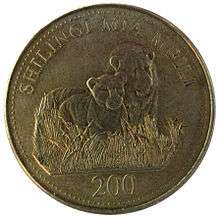
In 1966, coins were introduced in denominations of 5, 20 and 50 senti and 1 shilingi, with the 5 senti struck in bronze, the 20 senti in nickel-brass (copper-nickel-zinc) and the 50 senti and 1 shillingi in cupro-nickel. Cupro-nickel 5 shilingi coins were introduced in 1972, followed by scalloped, nickel-brass 10 senti in 1977. This First Series coins set, in circulation from 1966 up to 1984, was designed by Christopher Ironside OBE.[2]
In 1987, nickel-plated steel replaced cupro-nickel in the 50 senti and 1 shilingi, and cupro-nickel 5 and 10 shilingi coins were introduced, with the 5 shilingi decagonal in shape. In 1990, nickel-clad-steel 5, 10 and 20 shilingi were introduced, followed by brass-plated steel coins for 100 shilingi in 1993, 50 shilingi in 1996 and copper-nickel-zinc 200 shilingi in 1998.
Coins currently in circulation are the 50, 100 and 200 shilingi. A 500 shilingi coin was issued on 8 September 2014.[3]
| Tanzanian shilling coins | |||||||
|---|---|---|---|---|---|---|---|
| Image | Value | Composition | Diameter | Weight | Thickness | Edge | Issued |
.jpg) |
5 senti | bronze | 23.24 mm (dodecagonal) | 4.0 g | 1.33 mm | Smooth | 1966-1984 |
 |
10 senti | nickel-brass | 25 mm (scalloped) | 5.03 g | 1.49 mm | Smooth | 1977-1984 |
| 20 senti | nickel-brass | 24 mm | 5 g | Smooth | 1966-1984 | ||
| 50 senti | copper-nickel | 21 mm | 4 g | 1.6 mm | Reeded | 1966-1984 | |
| 50 senti | nickel-plated steel | 21 mm | 4 g | 1.8 mm | Reeded | 1988-1990 | |
| 1 shilingi | copper-nickel | 27.7 mm | 8 g | 1.62 mm | Reeded | 1966-1984 | |
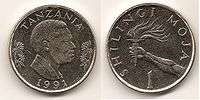 |
1 shilingi | nickel-plated steel | 23.5 mm | 6.5 g | Reeded | 1987-1992 | |
| 5 shilingi | copper-nickel | 31.5 mm (decagonal) | 13.8 g | 2.2 mm | Segmented; five smooth and reeded parts | 1972-1980 | |
| 5 shilingi | copper-nickel | 27.5 mm (decagonal) | 8.3 g | 2 mm | Segmented; five smooth and reeded parts | 1987-1989 | |
| 5 shilingi | nickel-plated steel | 27.5 mm (decagonal) | 8.52 g | 2 mm | Reeded | 1990-1993 | |
| 10 shilingi | copper-nickel | 29 mm | 9.7 g | 2 mm | Reeded | 1987-1989 | |
 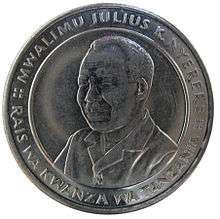 |
10 shilingi | nickel-plated steel | 29 mm | 10 g | 2.25 mm | Reeded | 1990-1993 |
| 20 shilingi | nickel-plated steel | 32 mm (heptagonal) | 13 g | 2 mm | Smooth | 1990-1992 | |
  |
50 shilingi | brass-plated steel | 22 mm (heptagonal) | 7.91 g | 2.9 mm | Smooth | 1996 |
 |
100 shilingi | brass-plated steel | 24.5 mm | 9 g | 2.7 mm | Reeded | 1993 |
 |
200 shilingi | copper-nickel-zinc | 26.8 mm | 8 g | 2 mm | Segmented; five smooth and reeded parts | 1998 |
  |
500 shilingi | nickel-plated steel | 27.5 mm | 9.5 g | 2.4 mm | Reeded | 2014 |
Banknotes
On 14 June 1966, the Benki Kuu Ya Tanzania (Bank of Tanzania) introduced notes for 5, 10, 20 and 100 shillingi (also denominated in shillings on the first series of notes). The 5 shillingi note was replaced by a coin in 1972. 50 shillingi notes were introduced in 1985, followed by 200 shilingi in 1986, 500 shillingi in 1989 and 1000 shillingi in 1990. The 10, 20, 50 and 100 shillingi notes were replaced by coins in 1987, 1990, 1996 and 1994, respectively. 5000 and 10,000 shillingi notes were introduced in 1995, followed by 2000 shilingi in 2003. A new series of notes came out in 2011. These new notes include many security features that prevent counterfeiting.[4][5]
Banknotes in circulation today are 500, 1000, 2000, 5000 and 10,000 shilingi.
| Older Series | |||||||||||
|---|---|---|---|---|---|---|---|---|---|---|---|
| Image | Value | Dimensions | Main Colour | Description | Date of issue | ||||||
| Obverse | Reverse | Obverse | Reverse | Watermark | |||||||
| 10/- (Ten Shillings) | - | Green | Julius Nyerere | Arusha Declaration Monument | Giraffe | - | |||||
 |
20/- (Twenty Shillings) | - | Blue-violet | Julius Nyerere | General Tyre East Africa Plant | ||||||
 |
 |
100/- (One Hundred Shillings) | - | Red | Julius Nyerere | Maasai | |||||
| 1997 Series[6] | ||||||||
|---|---|---|---|---|---|---|---|---|
| Image | Value | Dimensions | Main Color | Description | Date of issue | Watermark | ||
| Obverse | Reverse | |||||||
| 500/- (Shilingi Mia Tano) | 138 x 69 mm | Green | Tanzanian coat of arms; Giraffe; Zebra | Clove harvest; Uhuru Torch | 1997 | Giraffe | ||
| 1000/- (Shillingi Elfu Moja) | 142 x 71 mm | Red | Tanzanian coat of arms; Giraffe; African Elephant | Kiwira coal mine; Door of People's Bank of Zanzibar | ||||
| 1000/- (Shilingi Elfu Moja) | 142 x 71 mm | Red | Tanzanian coat of arms; Julius Nyerere; African Elephant | Kiwira coal mine; Door of People's Bank of Zanzibar | 2000/- | |||
| 5000/- (Shillingi Elfu Tano) | 145 x 73 mm | Purple | Tanzanian coat of arms; Giraffe; Rhino | Giraffes; Mt Kilimanjaro | 1997 | |||
| 10,000/- (Shilingi Elfu Kumi) | 149 x 75 mm | Indigo | Tanzanian coat of arms; Giraffe; Lion | Bank of Tanzania; "House of Wonder" (Zanzibar) | ||||
| These images are to scale at 0.7 pixel per millimetre. For table standards, see the banknote specification table. | ||||||||
| 2003 Series | |||||||||||
|---|---|---|---|---|---|---|---|---|---|---|---|
| Image | Value | Dimensions | Main Colour | Description | Date of issue | ||||||
| Obverse | Reverse | Obverse | Reverse | Watermark | |||||||
| 500/- (Shilingi Mia Tano) | 130 × 63 mm | Green | African Buffalo | Nkrumah Hall, University of Dar es Salaam | Giraffe | 2003 | |||||
| 1000/- (Shilingi Elfu Moja) | 135 × 66 mm | Blue | Julius Nyerere | Statehouse, Dar es Salaam | |||||||
 |
 |
2000/- (Shillingi Elfu Mbili) | 140 × 69 mm | Orange-brown | Lion, Mount Kilimanjaro | Old Fort, Stone Town, Zanzibar | |||||
 |
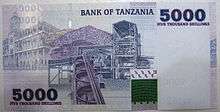 |
5000/- (Shillingi Elfu Tano) | 145 × 72 mm | Purple | Black Rhinoceros | Geita gold Mine and House of Wonders Zanzibar | |||||
 |
 |
10,000/- (Shillingi Elfu Kumi) | 150 × 75 mm | Red | Elephant | Bank of Tanzania headquarters in Dar es Salaam | |||||
| These images are to scale at 0.7 pixel per millimetre. For table standards, see the banknote specification table. | |||||||||||
Currently in Circulation
| 2011 Series[7] | |||||||||
|---|---|---|---|---|---|---|---|---|---|
| Image | Values | Dimensions | Main Color | Description | Date of issue | Date of first issue | Watermark | ||
| Obverse | Reverse | Obverse | Reverse | ||||||
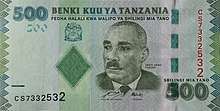 |
 |
500/- (Shilingi Mia Tano) | 120 x 60 mm | Green | Tanzanian coat of arms; Sheikh Abeid Amani Karume | University of Dar es Salaam central hall building; graduating students wearing caps and gowns; Aesculap's rod | 2011 | 1 January 2010 | Julius Kambarage Nyerere with electrotype 500 |
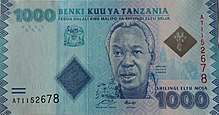 |
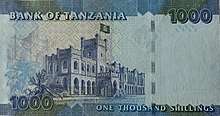 |
1000/- (Shillingi Elfu Moja) | 125 x 65 mm | Blue | Tanzanian coat of arms; President Julius Kambarage Nyerere; Bismarck Rock in Mwanza Harbor | Coffee plant; State House (Ikulu) building with flag in Dar es Salaam | Julius Kambarage Nyerere with electrotype 1000 | ||
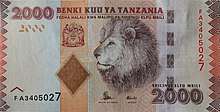 |
 |
2000/- (Shilingi Elfu Mbili) | 130 x 66 mm | Orange | Tanzanian coat of arms; Lion | Palm trees; old Omani Arab Fort (Ngome Kongwe) in Zanzibar’s Stone Town; carved block | Julius Kambarage Nyerere with electrotype 2000 | ||
 |
 |
5000/- (Shillingi Elfu Tano) | 135 x 67 mm | Purple | Tanzanian coat of arms; plant; black rhinoceros | Cyanid Leaching plant of the gold mines of Geita | Julius Kambarage Nyerere with electrotype 5000 | ||
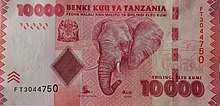 |
 |
10,000/- (Shilingi Elfu Kumi) | 140 x 68 mm | Red | Tanzanian coat of arms; Elephant | Flowers; Bank of Tanzania headquarters building in Dar es Salaam | Julius Kambarage Nyerere with electrotype 10000 | ||
| These images are to scale at 0.7 pixel per millimetre. For table standards, see the banknote specification table. | |||||||||
| Current TZS exchange rates | |
|---|---|
| From Google Finance: | AUD CAD CHF EUR GBP HKD JPY USD CNY USD |
| From Yahoo! Finance: | AUD CAD CHF EUR GBP HKD JPY USD CNY USD |
| From XE.com: | AUD CAD CHF EUR GBP HKD JPY USD CNY USD |
| From OANDA: | AUD CAD CHF EUR GBP HKD JPY USD CNY USD |
| From fxtop.com: | AUD CAD CHF EUR GBP HKD JPY USD CNY USD |
See also
References
Notes
- Linzmayer, Owen (2012). "Tanzania". The Banknote Book. San Francisco, CA: www.BanknoteNews.com.
- "Bank of Tanzania: Banking Operations - Currency Museum: Coins". bot-tz.org. Retrieved 2015-09-03.
- "Image: IMG-20140907-WA0006.jpg, (960 × 1280 px)". bot.go.tz. Retrieved 2015-09-03.
- Tanzania new note family confirmed BanknoteNews.com. Retrieved 2011-10-22.
- The Citizen. Retrieved 2011-10-22.
- "Bank of Tanzania Historical Notes". bot. Bank of Tanzania. Retrieved 2015-07-05.
- "Tanzania new note family confirmed | Africa | Banknote News". banknotenews.com. Retrieved 2015-09-03.
Sources
- Krause, Chester L.; Clifford Mishler (1991). Standard Catalog of World Coins: 1801–1991 (18th ed.). Krause Publications. ISBN 0873411501.
- Pick, Albert (1994). Standard Catalog of World Paper Money: General Issues. Colin R. Bruce II and Neil Shafer (editors) (7th ed.). Krause Publications. ISBN 0-87341-207-9.
External links
| Wikimedia Commons has media related to Money of Tanzania. |
- Bank of Tanzania page on circulating banknotes
- The banknotes of Tanzania
- (in English, German, and French)
| Preceded by: East African shilling Reason: currency independence Ratio: at par Note: independent shilling introduced in 1966, but EA shilling not demonetized until 1969 |
Currency of Tanzania 1966 – |
Succeeded by: Current |
